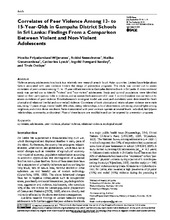| dc.contributor.author | Wijeratne, Monika Priyadarshani | en_US |
| dc.contributor.author | Seneviratne, Rohini | en_US |
| dc.contributor.author | Gunawardena, Nalika | en_US |
| dc.contributor.author | Lynch, Catherine | en_US |
| dc.contributor.author | Sandøy, Ingvild Fossgard | en_US |
| dc.contributor.author | Østbye, Truls | en_US |
| dc.date.accessioned | 2015-09-22T12:53:06Z | |
| dc.date.available | 2015-09-22T12:53:06Z | |
| dc.date.issued | 2014 | |
| dc.identifier.issn | 2158-2440 | |
| dc.identifier.uri | https://hdl.handle.net/1956/10501 | |
| dc.description.abstract | Violence among adolescents in schools is a relatively new research area in South Asian countries. Limited knowledge about factors associated with peer violence hinders the design of prevention programs. This study was carried out to assess correlates of peer violence among 13- to 15-year-old adolescents in Gampaha district schools in Sri Lanka. A cross-sectional study was carried out to identify “violent” and “non-violent” adolescents. Study and control populations were identified based on their participatory roles in violence, and an unmatched case–control (1 case: 1 control) analysis was carried out to assess correlates of peer violence. Bronfenbrenner’s ecological model was used, and correlates were determined for both physical and relational (verbal and non-verbal) violence. Correlates of both physical and relational peer violence were male sex, being 13 years of age, mental health difficulties, dating relationships, school absenteeism, witnessing physical fights among neighbors, and crime-dense residence. Factors associated with peer violence operate at several levels: individual, family/peer relationships, community, and societal. Most of these factors are modifiable and can be targeted by prevention programs. | en_US |
| dc.language.iso | eng | eng |
| dc.publisher | Sage | eng |
| dc.rights | Attribution CC BY | eng |
| dc.rights.uri | http://creativecommons.org/licenses/by/3.0/ | eng |
| dc.subject | Adolescents | eng |
| dc.subject | Peer violence | eng |
| dc.subject | Physical violence | eng |
| dc.subject | Relational violence | eng |
| dc.subject | Ecological model | eng |
| dc.title | Correlates of peer violence among 13-to-15-year-olds in Gampaha district schools in Sri Lanka: Findings from a comparison between violent and non-violent adolescents | en_US |
| dc.type | Peer reviewed | |
| dc.type | Journal article | |
| dc.date.updated | 2015-07-28T12:22:48Z | |
| dc.description.version | publishedVersion | en_US |
| dc.rights.holder | Copyright the author(s) 2014 | |
| dc.source.articlenumber | 2158244014550616 | |
| dc.identifier.doi | https://doi.org/10.1177/2158244014550616 | |
| dc.identifier.cristin | 1164535 | |
| dc.source.journal | Sage Open | |
| dc.source.40 | 4 | |
| dc.source.14 | 3 | |
| dc.subject.nsi | VDP::Medisinske fag: 700::Helsefag: 800::Samfunnsmedisin, sosialmedisin: 801 | |
| dc.subject.nsi | VDP::Midical sciences: 700::Health sciences: 800::Community medicine, social medicine: 801 | |
| dc.subject.nsi | VDP::Samfunnsvitenskap: 200::Psykologi: 260::Sosial- og arbeidspsykologi: 263 | |
| dc.subject.nsi | VDP::Social sciences: 200::Psychology: 260::Social and occupational psychology: 263 | |

